Jumping spiders are a massive group comprising over 6,000 species; they make up 13% of all spiders by themselves. As the name implies, they’re known for their jumping habits, but jumping spiders are remarkable for a number of reasons. From their unusual eyes to their surprising behavior, these animals are well worth our attention. Here’s why.
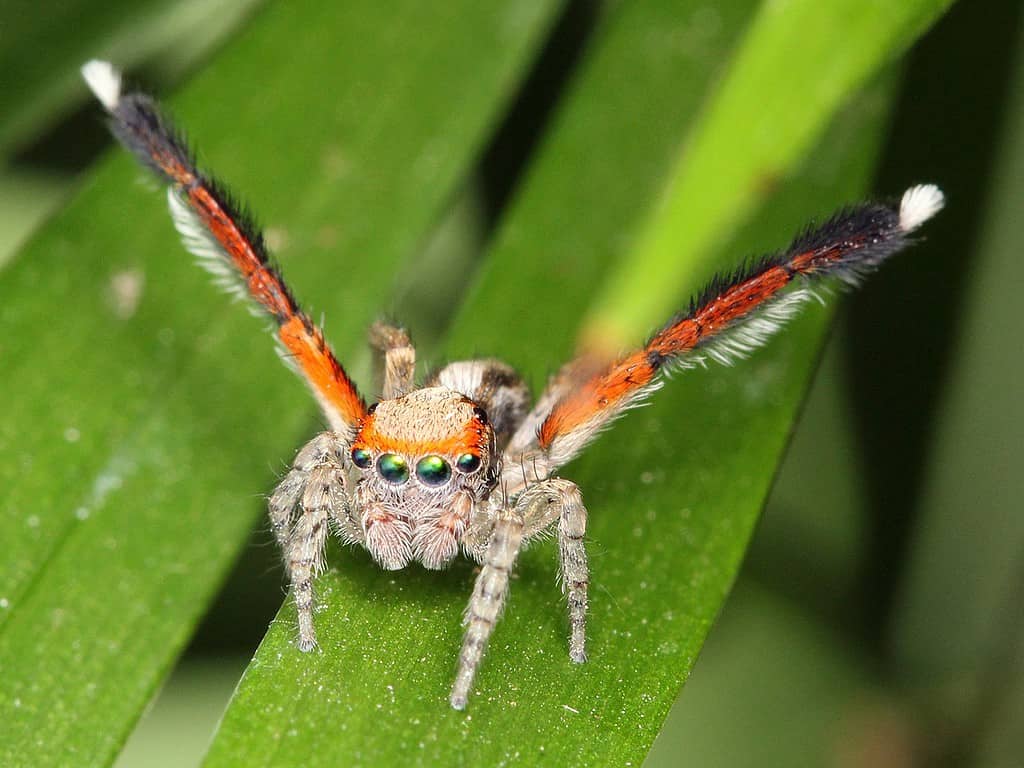
The Jumping Spider
Jumping spiders are part of a family called Salticidae, which is why they’re also called Salticids sometimes. According to 2019 statistics, this family includes over 600 described genera and over 6,000 species. But this statistic is already outdated. With new species like “Sparklemuffin” and “Skeletorus” being discovered every year, the jumping spider family is becoming more and more numerous.
Jumping spiders can be found all over the world, and range in size from just 1 mm in length to 23 mm (almost an inch). They’re a respectably old group of spiders, though definitely not one of the pioneers of this group. Very few jumping spider fossils have been found, but these include amber fossils that date from 54 to 42 million. It’s believed that that’s around when the jumping spiders started evolving. For comparison, the earliest spiders date to 380 million years ago.
Most of them are textbook active hunters, with several species being able to bring down species much larger than themselves. In other words, they don’t really use webs that much — in fact, most species of jumping spiders don’t even build webs to catch prey, they simply use them for reproductive activities.
Among the most spectacular thing about jumping spiders is their eyes.
Jumping spiders have very distinguishable eyes. They have four pairs of eyes, with one anterior pair being particularly large.
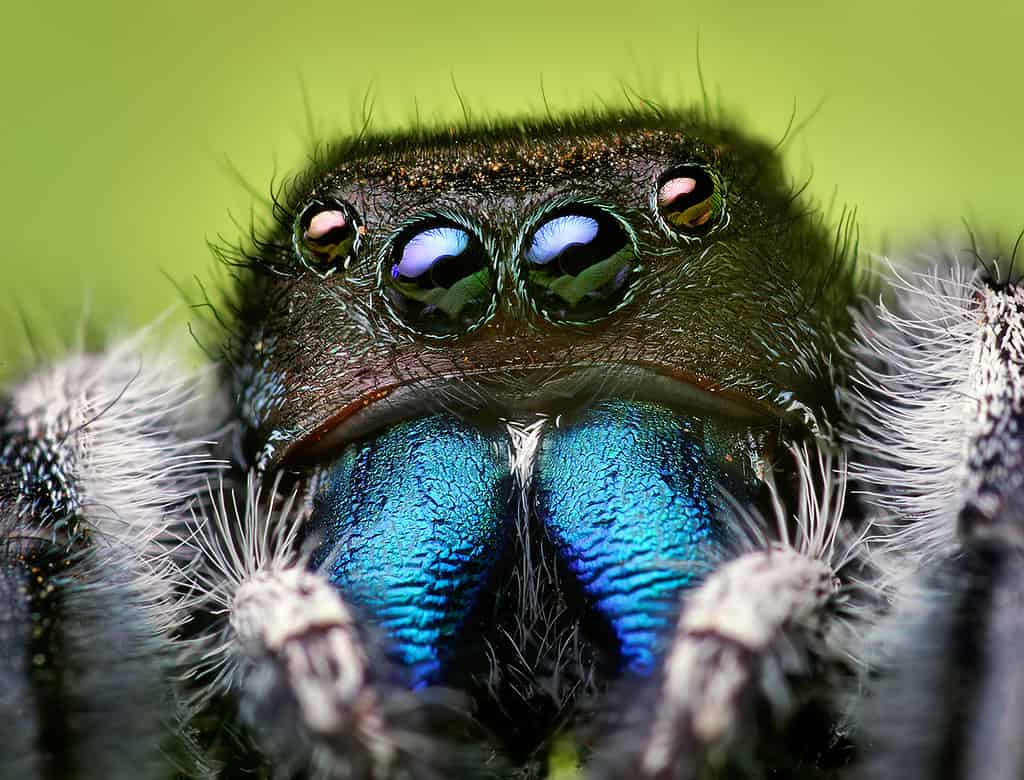
This enlarged pair of eyes offer them very good vision, which is rather unusual among spiders. Jumping spiders generally have tetrachromatic color vision, which means they see four primary colors (unlike humans, for instance, which see three primary colors). They’ve also developed an unusual way to perceive depth.
Their eyes are too close together to enable proper depth perception, and jumping spiders don’t make use of motion parallax (the mechanism through which animals like owls perceive depth). So instead, the spiders have developed a method called image defocus. They defocus parts of their sight, and based on how defocused they are, they calculate the distance and depth.
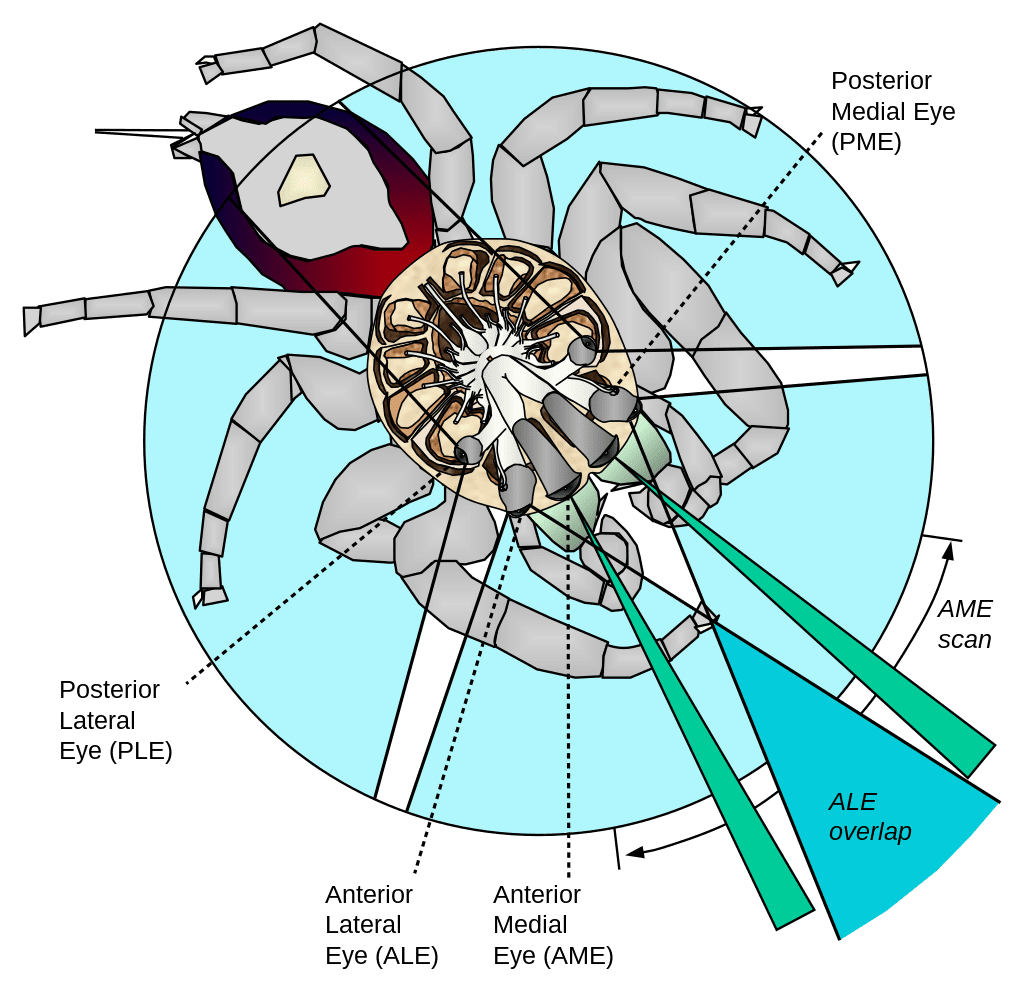
Of course, another important factor that sets jumping spiders aside from other spiders (or at least most of them) is the jumping. If you’re looking for a tiny creature that packs a big punch in the acrobatics department, look no further than the jumping spider.
Most species tend to have larger, muscular front legs that help with grasping and holding the prey. Remarkably, it’s their smaller hind legs that help with jumping. Some species can jump a whopping 30 times their body length — that’s the rough equivalent of a human jumping 50 meters (or 168 feet). However, most species “only” jump around 3-4 times their body length.
So if it’s not muscles, how do jumping spiders leap so much? Turns out, they do it by shifting their blood pressure and contracting their small muscles very intensely. They create a surge of blood flow to the lext which forces them to extend rapidly, snapping in a big leap.
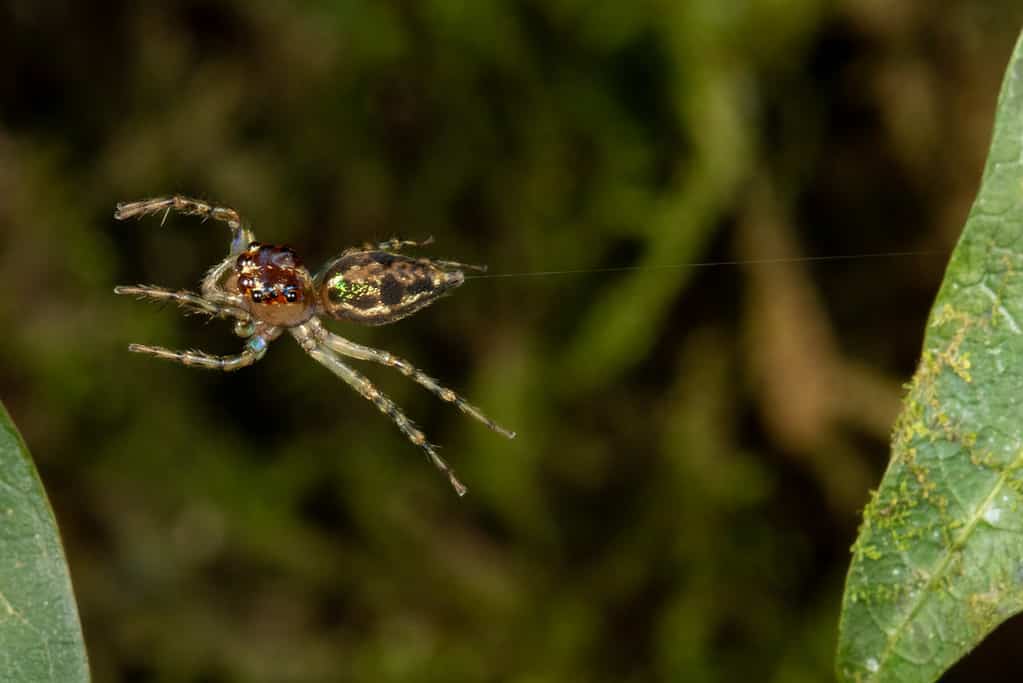
The species also tries to keep safe during these major leaps. Right before a leap, jumping spiders will typically tether themselves with a filament of silk to whatever they can and use this as a dragline. If it doesn’t work, the spider will climb up the silk tether and try again.
They usually jump either to attack prey or to escape threats, but there’s much about their behavior we don’t understand yet.
What Makes Jumping Spiders Special
Jumping spiders are incredibly unique creatures, with a number of fascinating characteristics that make them stand out from other spiders. As if the vision and jumping weren’t enough, they are also incredibly diverse, coming in a wide range of colors, shapes, and sizes.
But jumping spiders aren’t just visually impressive.
Another unique feature of jumping spiders is their courtship behaviors. Male jumping spiders will often perform elaborate dance routines to attract a mate, waving their front legs and displaying their brightly colored bodies in a showy display. They will also engage in tactile communication, using their legs to tap out a specific pattern on the ground to signal their intentions to potential mates.
Another peculiarity of jumping spiders is their milk. Yes, some spiders have ‘milk’ and it’s very nutritious. Uniquely among spiders, jumping spiders care for their brood for a long time, until they become sexually mature.
There are plenty of other unusual things about some species of jumping spiders. For instance, in 2013, researchers found the first (mainly) vegetarian spider — and yep, it was a jumping spider. Bagheera kiplingi, named after the Jungle Book panther Bagheera and the story’s author, Rudyard Kipling, loves eating acacia. Even more, this species of spider is the first known to eat solid vegetative food at all. They occasionally prey on small invertebrates, but usually, it’s plants.
“This is really the first spider known to specifically ‘hunt’ plants; it is also the first known to go after plants as a primary food source,” said research Christopher Meehan, who took notice of the spiders during a field course in Mexico, in 2013.
This was further confirmed a couple of years later when researchers found yet another type of jumping spider that mostly consumes plants.
Another surprising find is that they seem to sleep just like us. In 2022, a study looked at their leg twitches, which are remarkably similar to the twitches of humans. According to the findings, these eight-legged critters do indeed enter a “REM sleep-like state” at night.
They also have ‘spidey senses’. Although they don’t have ears, they can hear you talking across the room by tracing vibrations.
Researchers also trained jumping spiders to jump on demand, showing that in addition to their remarkable physical abilities; some species of jumping spiders also exhibit a remarkable ability to plan and solve problems, hinting that they may also be more brainy than you think — despite technically not having a brain.
Cute Jumping Spiders
Spiders aren’t usually known for their cuteness, but jumping spiders are definitely some of the prettiest arachnids you’ll ever see.
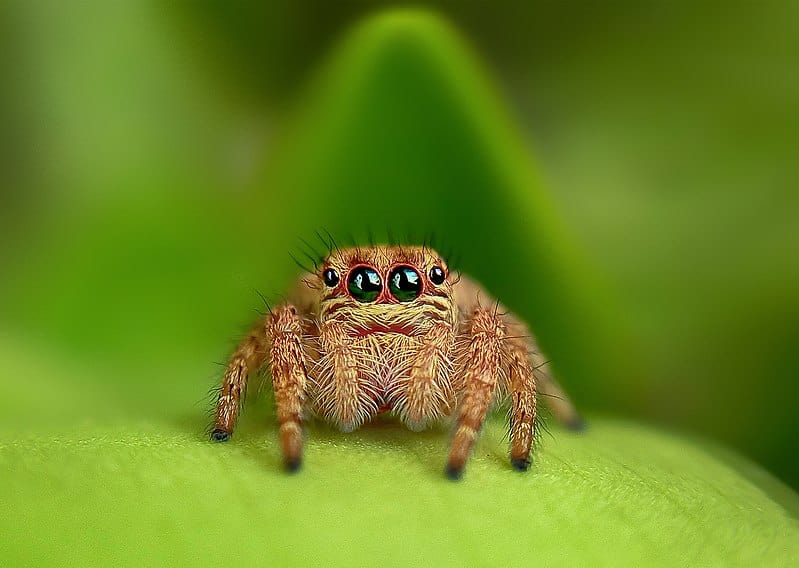
Humans are hardwired to like big eyes, so we instinctively consider things like jumping spiders, whose eyes stand out, to be cute. However, this conflicts with our instinct to dislike spiders. Hopefully, however, we can overcome our basic instincts and regard jumping spiders in a more rational light.
Jumping spiders are rarely, if ever, dangerous to humans. They’re typically harmless and generally run away rather than confront you. The old saying still goes here: they’re way more afraid of you than you are of them.
If you’re still not convinced that jumping spiders can be cute, maybe this will change your mind: some researchers found out that they follow laser pointers just like cats.
So they’ve got big eyes, they’re not all predators, they’re cat-like in some regards, and human-like in others. For a spider, that’s about as cute as it gets.
Can You Keep a Jumping Spider as a Pet?
Jumping spiders are becoming increasingly popular as pets, thanks to their unique personalities and fascinating behaviors. However, keeping a jumping spider as a pet requires some specialized knowledge and equipment, and it’s not the easiest thing in the world.
First of all, requirements can vary from species to species. Their personalities also vary, both from species to species and from individual to individual. Jumping spiders have become viral as pets on TikTok, but not all are curious — some are more shy. Be sure to talk to the veterinarian or another specialist to ensure the spider has all its needs and always handle it with care.
Despite these challenges, many people find that keeping a jumping spider as a pet is a rewarding and enjoyable experience.
Types of Jumping Spiders
As mentioned, there are literally thousands of different species of jumping spiders so we don’t even try to get into that. Instead, we’ll simply discuss some of the interesting or popular species.
The Peacock Jumping Spider
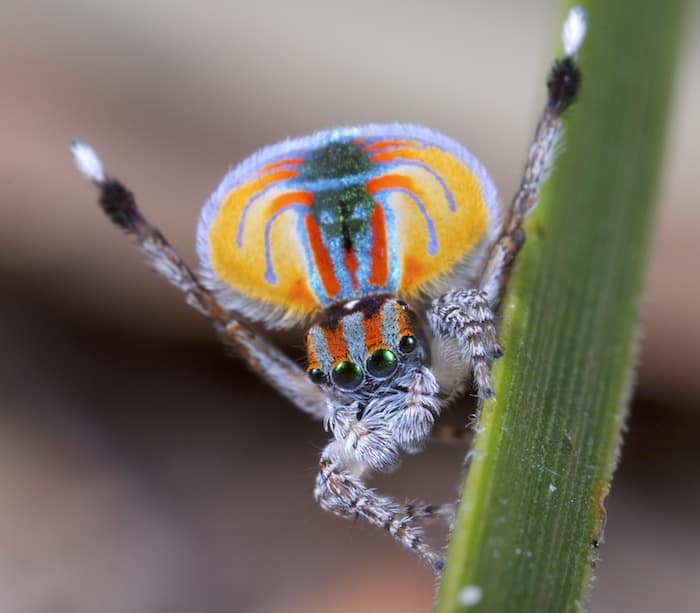
One of the most stunning species of jumping spiders is the peacock jumping spider (Maratus volans), which is found in Australia. The male of this species is known for its vibrant colors and intricate mating display, which involves lifting its legs and fanning out a colorful flap on its abdomen. This display is thought to attract females and made the peacock jumping spider a popular subject of study among biologists and arachnologists.
The Bold Jumping Spider
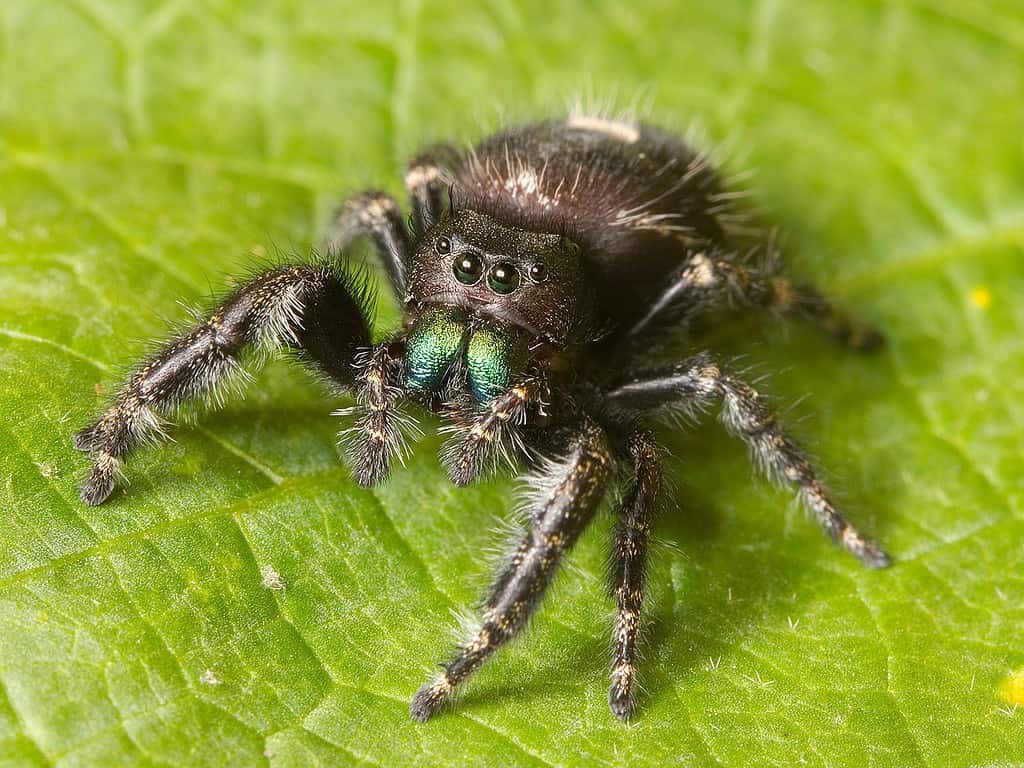
The daring jumping spider or bold jumping spider (Phidippus audax) is another species that is known for its impressive jumping ability. These spiders are found throughout North and Central America, and are known for their bold and curious nature.
They are often seen exploring their surroundings and hunting for prey, and have been known to take on much larger insects such as grasshoppers and beetles.
Bold jumping spiders are also a useful species in agricultural environments, as they typically consume many crop pests including bollworms, boll weevils, spotted cucumber beetles, sorghum midges, and stink bugs.
The Tan Jumping Spider
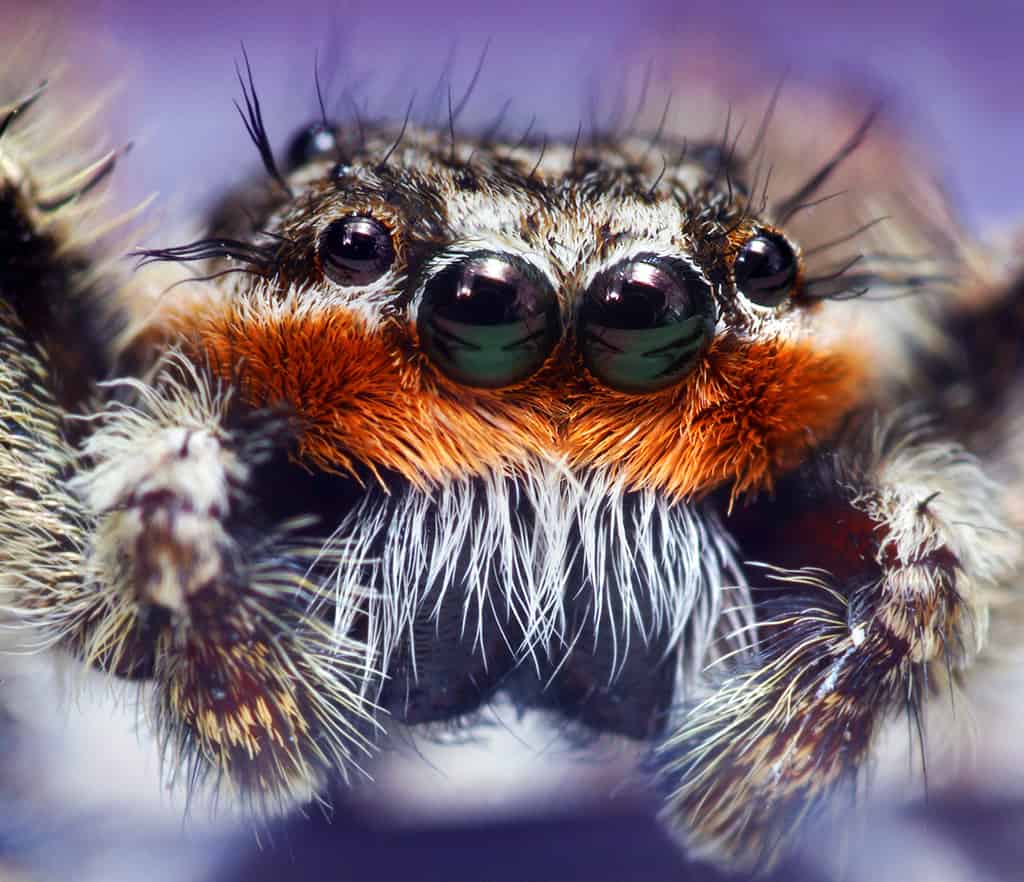
The tan jumping spider (Platycryptus undatus) is a common species found throughout much of the United States. These spiders are known for their distinctive markings, which include a tan body with dark stripes and a lot of “fur”. Tan jumping spiders are so fluffy they almost seem mammal-like in nature.
Portia Jumping Spider
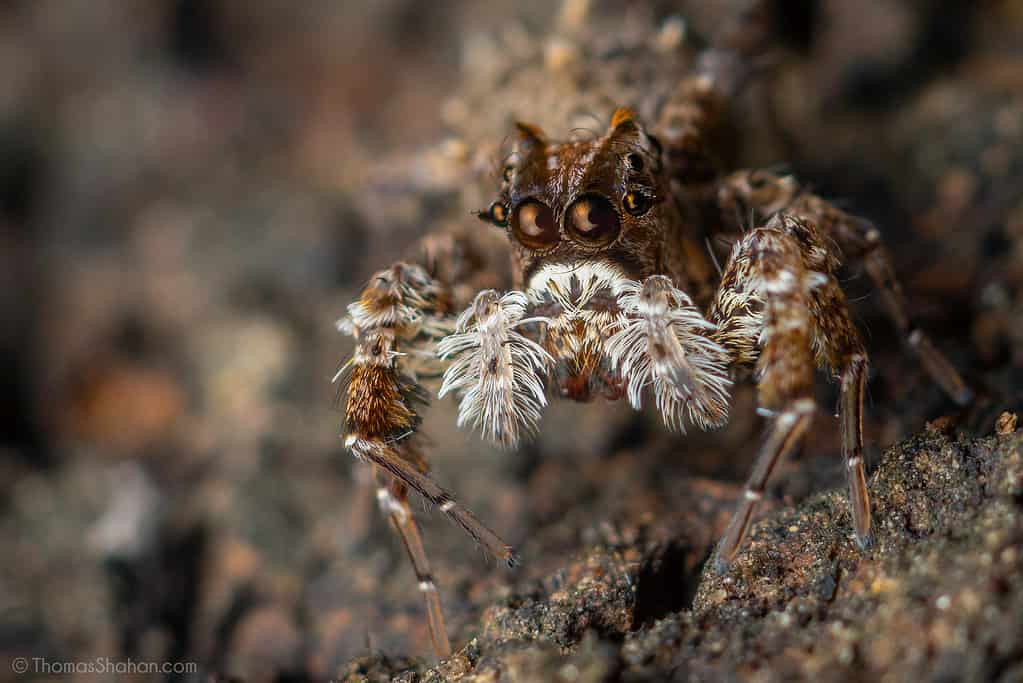
Portia jumping spiders are some of the most intelligent spiders and exhibit a striking ability to plan hunts and solve problems. All Portia jumping spiders have some instinctive hunting tactics, but they can improvise by trial and error against unfamiliar prey or in unfamiliar situations, and then remember the new approach.
They’ve even shown an inclination to try new things simply for the sake of trying, which again is a remarkably advanced behavior. Still, despite their apparently advanced behavioral patterns and intellectual adaptability, they are slow thinkers, presumably due to their low biological processing power.
No doubt, there’s plenty we still haven’t figured out about jumping spiders. But even based on what we have learned, they seemed to be a massively impressive group, with several striking abilities.
From the colorful mating dances of the peacock spider to the careful planning of the Portia, this group shows that spiders aren’t simply mindless killing machines — and they’re worthy of far more than just our contempt.


